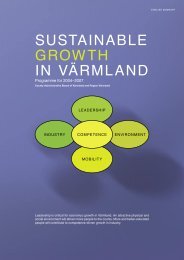PDF (222 KB) - Document Database website
PDF (222 KB) - Document Database website
PDF (222 KB) - Document Database website
You also want an ePaper? Increase the reach of your titles
YUMPU automatically turns print PDFs into web optimized ePapers that Google loves.
ACHIEVING THE LISBON GOALS<br />
THE CONTRIBUTION OF VOCATIONAL EDUCATION AND TRAINING IN ROMANIA<br />
The relatively high employment rate, and of<br />
those aged 50 or over in particular, can be<br />
explained by the high rate in agriculture,<br />
most of which can be characterised as<br />
subsistence employment. Thus in the<br />
fourth quarter of 2003 the employment rate<br />
of the population aged 55–64 years was<br />
19.9% in urban areas and 53.8% in rural<br />
areas. The employment rate of the<br />
population aged over 65 years is also high,<br />
though it is decreasing. Data from the<br />
second (spring) quarter showed a rate of<br />
25.7% in 2002 and 19.6% in 2003. The<br />
rates for the previous years, based on a<br />
slightly different definition, were also high,<br />
at 38.2% in 2000 and 37.5% in 2001.<br />
Employment rate (%) of the population<br />
over 65 years based on data for second<br />
(spring) quarter<br />
2000 2001 2002 2003<br />
Bulgaria 2.9 2.5 3.0 4.2<br />
Romania 38.2 37.5 25.7 19.6<br />
EU-15 3.3 3.3 3.5 m<br />
Source: Eurostat (New Cronos database)<br />
[m]: Missing data<br />
A closer look at the employment rate by<br />
educational attainment for the age group<br />
over 65 years shows that the rate is higher<br />
for low-skilled persons. Taking into<br />
consideration the over-employment in<br />
agriculture it is very likely that many<br />
low-skilled workers are registered as being<br />
employed in this sector.<br />
Employment rate of the population over<br />
65 years by educational attainment<br />
Lower<br />
secondary<br />
or below<br />
(ISCED 0–2)<br />
Upper<br />
secondary<br />
(ISCED 3 or 4)<br />
Tertiary<br />
(ISCED 5–6)<br />
2000 2001 2002 2003<br />
44.7 44.2 30.7 23.0<br />
11.7 11.2 6.4 7.0<br />
8.1 4.2 3.5 4.9<br />
Source: Eurostat (New Cronos database)<br />
With regard to encouraging older people<br />
(aged 55 and over) to remain at work<br />
longer, the new regulations of Law No<br />
107/2004 amending Law No 76/2002 on<br />
the system of unemployment<br />
compensation and employment incentives<br />
are relevant. Article 85 (5) of the law<br />
specifies the Unemployment Fund amount<br />
– the equivalent of the national gross<br />
minimum wage in force at the time – to be<br />
granted as an incentive to employers who<br />
hire unemployed persons reaching<br />
retirement age within three years of the<br />
hiring date.<br />
Low participation in lifelong learning<br />
among older workers<br />
The data on the participation of persons<br />
aged 55 and over in CVT programmes and<br />
other forms of lifelong learning are less<br />
than encouraging. According to the<br />
Characteristics of Lifelong Learning Survey<br />
carried out by the National Statistics<br />
Institute in 2003, the number of individuals<br />
aged 50 to 64 years who had participated<br />
in various forms of training was 7.4%; the<br />
proportion for those aged 65 and over was<br />
2.9% of all participants. In a general<br />
context, however, the registered rate of<br />
participation in continuing education of<br />
those aged 15 and over was 18.1%. A<br />
similar trend is reflected in the data from<br />
the Ministry of Labour, Social Solidarity and<br />
Family on the numbers of individuals<br />
involved in training, conversion and<br />
refresher courses, and by the National<br />
Agency for Employment’s data on training<br />
for the unemployed. In 2003 around<br />
24 000 unemployed people participated in<br />
training programmes, of which more than<br />
30% were aged 25 or less.<br />
The data reflect, on the one hand, the<br />
relatively low level of interest of older<br />
people in vocational training and the<br />
absence of incentives; on the other hand,<br />
the data also reflect the reluctance of<br />
employers to invest in labour force training<br />
in general, and in particular, in the training<br />
of the labour force pertaining to this age<br />
group.<br />
12








